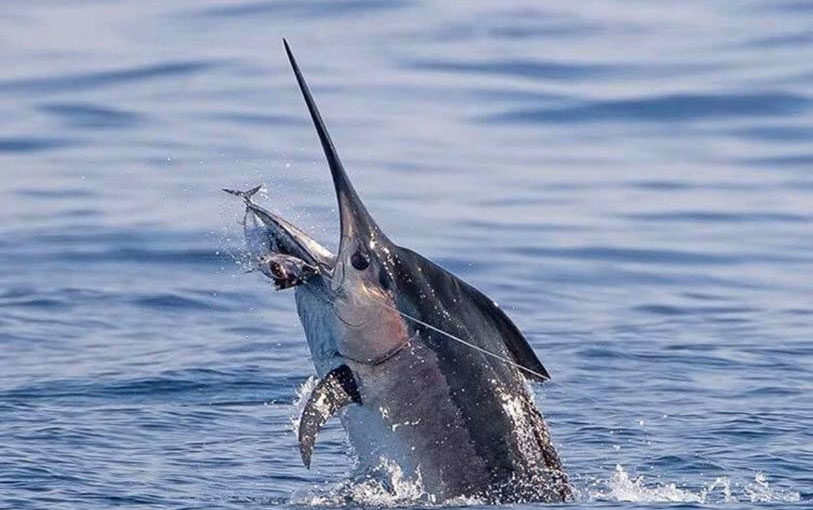Pro Techniques for Live-Bait Fishing
Master these time-tested techniques
Lures and dead bait will fool game fish on a regular basis, but there’s no substitute for the real thing. Few species will pass up a frisky live bait: It’s an incredibly effective technique for sailfish as well as mahi mahi and tuna — and even marlin. But there’s much more to suspending a live bait from a kite than just pinning one on a hook and tossing it over the side.
For a few insider tips, we enlisted the help of Jeff Scott, captain of The Sailsmen Fishing Team and a veteran of the South Florida sailfish circuit. We also checked in with Capt. Jimbo Thomas of the Miami-based charter boat Thomas Flyer for his thoughts.
“For the kite baits, we usually start with goggle-eyes on the long lines farthest away from the boat,” Scott says. “We’ll go with threadfins or sardines on the middle and short lines. And we bridle all our baits.” The team’s rigging begins with a VMC 5/0 circle hook that’s snelled to 40-pound-test fluorocarbon leader, although the team will drop down to 30-pound-test leaders on flat-calm days. You’ll also need a good supply of small rubber rigging bands and an open-eye rigging needle. “Loop the rubber band around the hook and attach the rigging needle,” Scott says. “Then run it through the nose of the bait. Pass the other end of the rubber band over the point of the hook, remove the rigging needle, then twist the hook twice and run it back under the rubber band to secure the hook to the bait.”
Scott prefers to bridle his baits through the nose when first starting the day, as this gives him the flexibility to move around a bit. “If it’s calm or we get set up in an area that we’re not moving around very much, we will bridle the baits in the back just below the front of the dorsal fin to give them a little more action.”
Thomas and his crew take a slightly different approach to their live-baiting, starting with the terminal tackle. “We’re using Daiwa Saltiga and Saltist reels spooled with high-vis 20-pound-test line and 10 to 15 feet of 50- or 60-pound monofilament leader in either clear or pink,” he says. “We don’t bother with fluorocarbon. And we don’t use swivels either: The leader is tied to the double line with an Albright knot. Our hooks are Mustad, and we also use a float and a small egg sinker on the leader.”
A rubber band is half-hitched on the leader three or four times to create a sliding stopper for the float and sinker that can easily be wound down to the fish as the leader comes through the rod guides during a release. Following a release, the system is ready to go after a new circle hook is tied to the leader and the float and weight are adjusted to the correct length with the rubber band.
Thomas also likes the Gerry Rig (livebaitclip.com), a small clip that attaches to the hook with a tiny rubber band. Thanks to its innovative design, the Gerry Rig grabs on to a live bait and doesn’t let go, eliminating the need for rigging needles or bridles. “I’ve got about five or six years of experience using this rig, and it works very well,” Thomas reports. “The hookup ratio isn’t any better or worse than if you bridle the bait, but the difference is the Gerry Rig is so much faster to use.
The baits are back in the water in just a few seconds and aren’t being handled as much, so they tend to stay alive much longer.” Thomas says baits can be pinned either through the back for kite-fishing or through the nose to be slow-trolled from the riggers. The Gerry Rig can be retrieved from any game fish landed, and it’s inexpensive, so losing one when releasing a sailfish is worth it.
Connect a small rubber rigging band to a circle hook, then to an open-eye rigging needle. Insert the needle through the nose of the bait just ahead of the eyes.
Using the rigging needle, gently pull the rubber band through the bait’s nose to the other side. Remove the rigging needle and set it aside for now.
Loop the rubber band back over the circle hook. Note the positioning in the bait’s nose: Live baits can also be bridled through the back just below the dorsal fin.
Twist the hook twice and then run the hook point back under the rubber band from front to back so the hook emerges as shown. The bait is now ready to fish.
Jeff Scott fishes 12 to 15 sailfish tournaments a year as captain of The Sailsmen Fishing Team aboard a 39-foot SeaVee, which is owned by Michael Kornahrens and based out of Hillsboro Inlet, Florida.
A native of Miami, Capt. Jimbo Thomas has charter-fished aboard Thomas Flyer since 1981, earning a reputation as one of the top captains in the region.





























